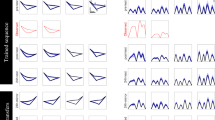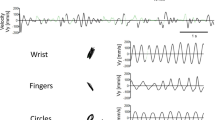Abstract
Structural learning suggests that the human nervous system learns general rules that can be applied when controlling actions involving similar structures (e.g. using a variety of bicycles when learning to ride). These general rules can then facilitate skill acquisition in novel but related situations (e.g. a new bicycle). We tested this concept by investigating whether learned asymmetries in handwriting (greater ease in moving the hand rightwards and downwards within Western-educated populations) are present in the non-preferred hand as predicted by structural learning. We found these asymmetries in both hands of a right-handed population when tracing abstract shapes. We then ruled out biomechanical explanations by finding the same results with a left-handed population. These findings provide support for structural learning and explain: (1) the rapidity with which individuals can learn to write with their non-preferred hand; (2) the presence of a higher abstract (effector independent) level within voluntary motor control organisation.


Similar content being viewed by others
References
Abeele S, Bock O (2001) Mechanisms for sensorimotor adaptation to rotated visual input. Exp Brain Res 139:248–253
Blank R, Miller V, von Voß H (2000) Human motor development and hand laterality: a kinematic analysis of drawing movements. Neurosci Lett 295(3):89–92
Bonoti F, Vlachos F, Metallidou P (2005) Writing, drawing performance of school aged children: is there any relationship? Sch Psychol Int 26(2):243–255
Braun DA, Aersten A, Wolpert DM, Mehring C (2009) Motor task variation induces structural learning. Curr Biol 19(4):352–357
Chapman J, Henneberg M (1999) Switching the handedness of adults: results of 10 weeks training of the non-preferred hand. Perspect Hum Biol 4(1):211–217
Culmer PR, Levesley MC, Mon-Williams M, Williams JHG (2009) A new tool for assessing human movement: the kinematic assessment tool. J Neurosci Methods 184:184–192
Meulenbroek RGJ, van Galen GP (1986) Movement analysis of repetitive writing behaviour of first, second and third grade primary school children. In: Kao HSR, van Galen GP, Hoosain R (eds) Graphonomics: contemporary research in handwriting. North-Holland, Amsterdam, pp 71–92
O’Mahony P, Dempsey M, Killeen H (2008) Handwriting speed: duration of testing period, relation to socio-economic disadvantage, handedness. Occup Ther Int 15(3):165–177
Oldfield RC (1971) The assessment and analysis of handedness: the Edinburgh inventory. Neuropsychologia 9:97–113
Plamondon R, Alimi AM (1997) Speed/accuracy trade-offs in target-directed movements. Behav Brain Sci 20(2):279–303
Provins KA, Magliaro J (1993) The measurement of handedness by preference and performance tests. Brain Cogn 22:171–181
Sovik N, Arntzen O (1991) A developmental study of the relation between movement patterns in letter combinations (words) and writing. In: Wann J, Wing AM, Sovik N (eds) Development of graphic skills: research, perspectives and educational implications. Academic Press, San Diego, pp 77–90
Thorndike L, Woodworth RS (1901) The influence of improvement in one mental function upon efficiency of other functions. Psychol Rev 8:247–261
Thoroughman KA, Shadmehr R (2000) Learning of action through adaptive combination of motor primitives. Nature 407:742–747
Tresilian JR (1999) Abstract levels of motor control in prehension: normal and pathological performance. Hum Mov Sci 18:219–239
Walker L, Henneberg M (2007) Writing with the non-dominant hand: cross-handedness trainability in adult individuals. Laterality Asymmetries Body Brain Cogn 12(2):121–130
Wolpert DM, Flanagan JR (2010) Motor learning. Curr Biol 20(11):R467–R472
Acknowledgments
We are grateful to The Magstim Company Limited and the Biomedical and Health Research Centre at the University of Leeds for their support of this project.
Author information
Authors and Affiliations
Corresponding author
Rights and permissions
About this article
Cite this article
Johnson, R.L., Culmer, P.R., Burke, M.R. et al. Exploring structural learning in handwriting. Exp Brain Res 207, 291–295 (2010). https://doi.org/10.1007/s00221-010-2438-5
Received:
Accepted:
Published:
Issue Date:
DOI: https://doi.org/10.1007/s00221-010-2438-5




